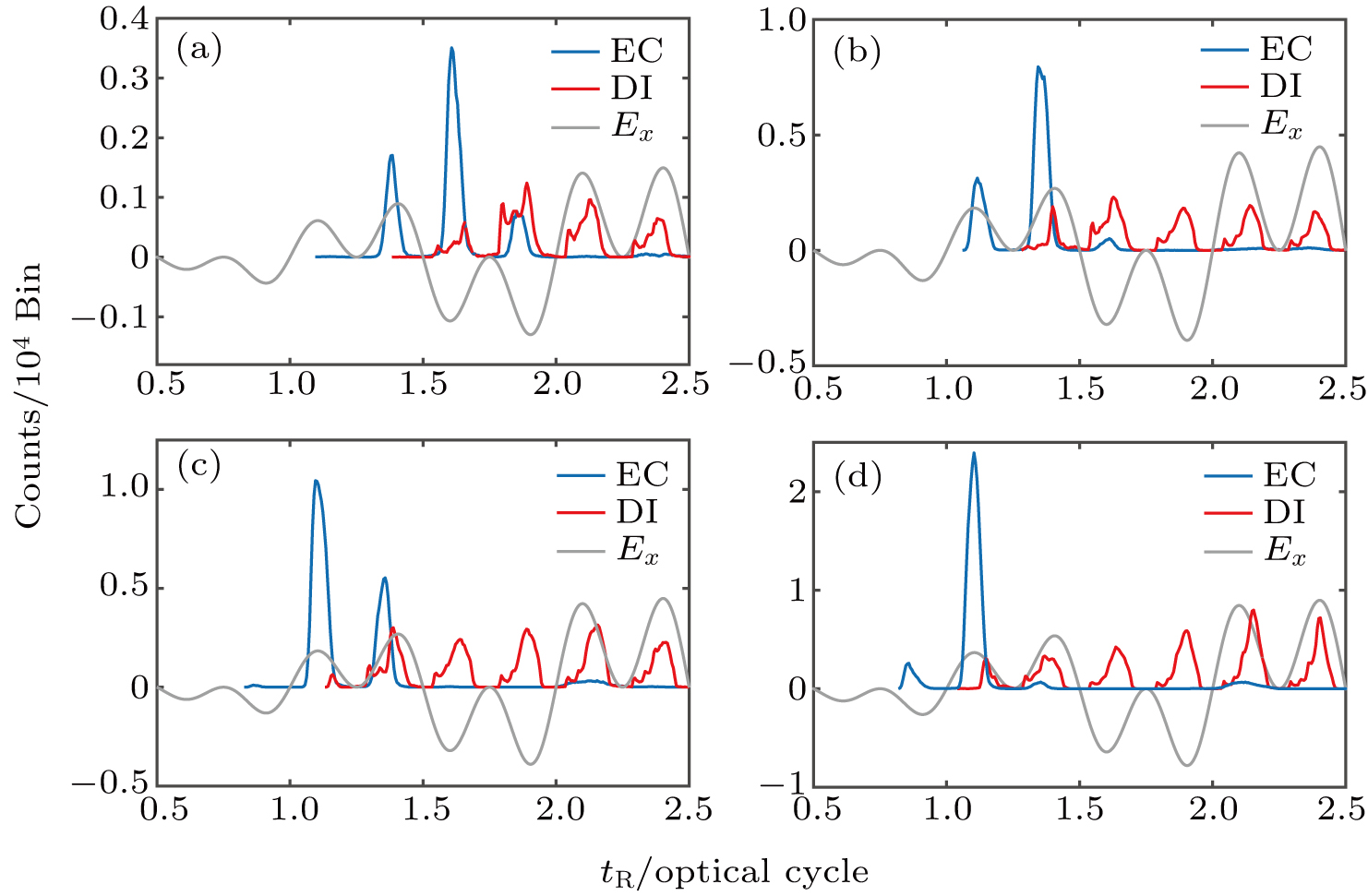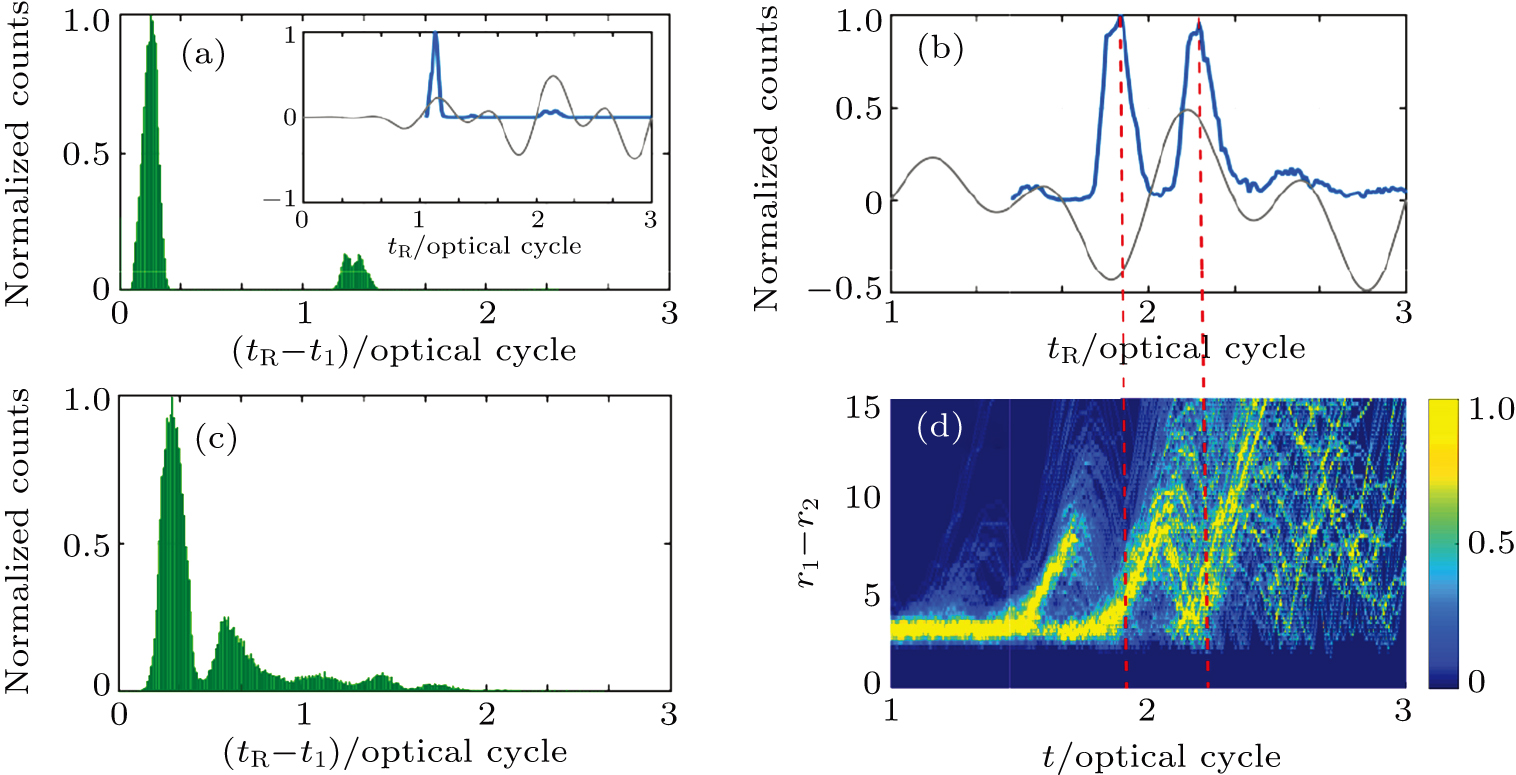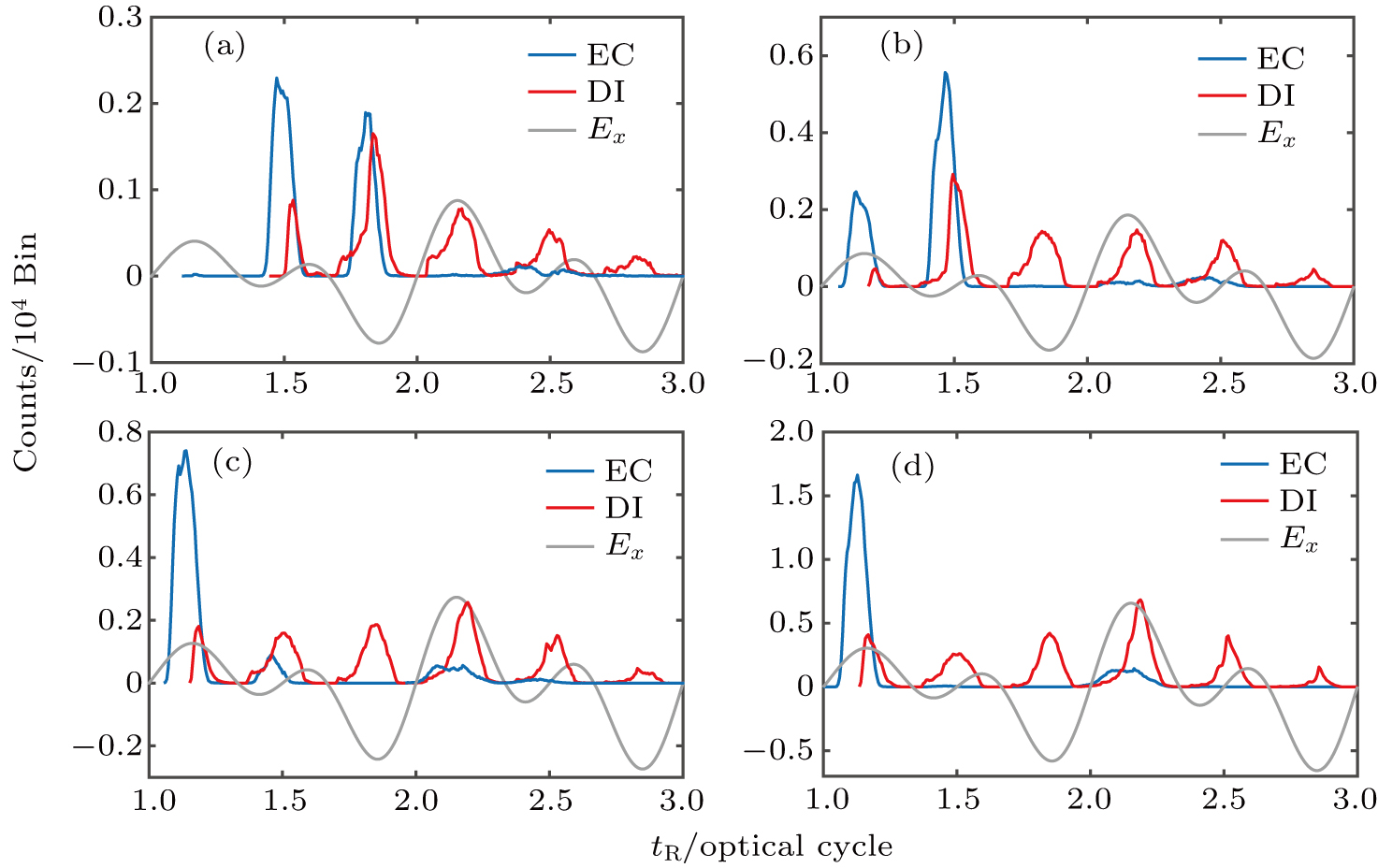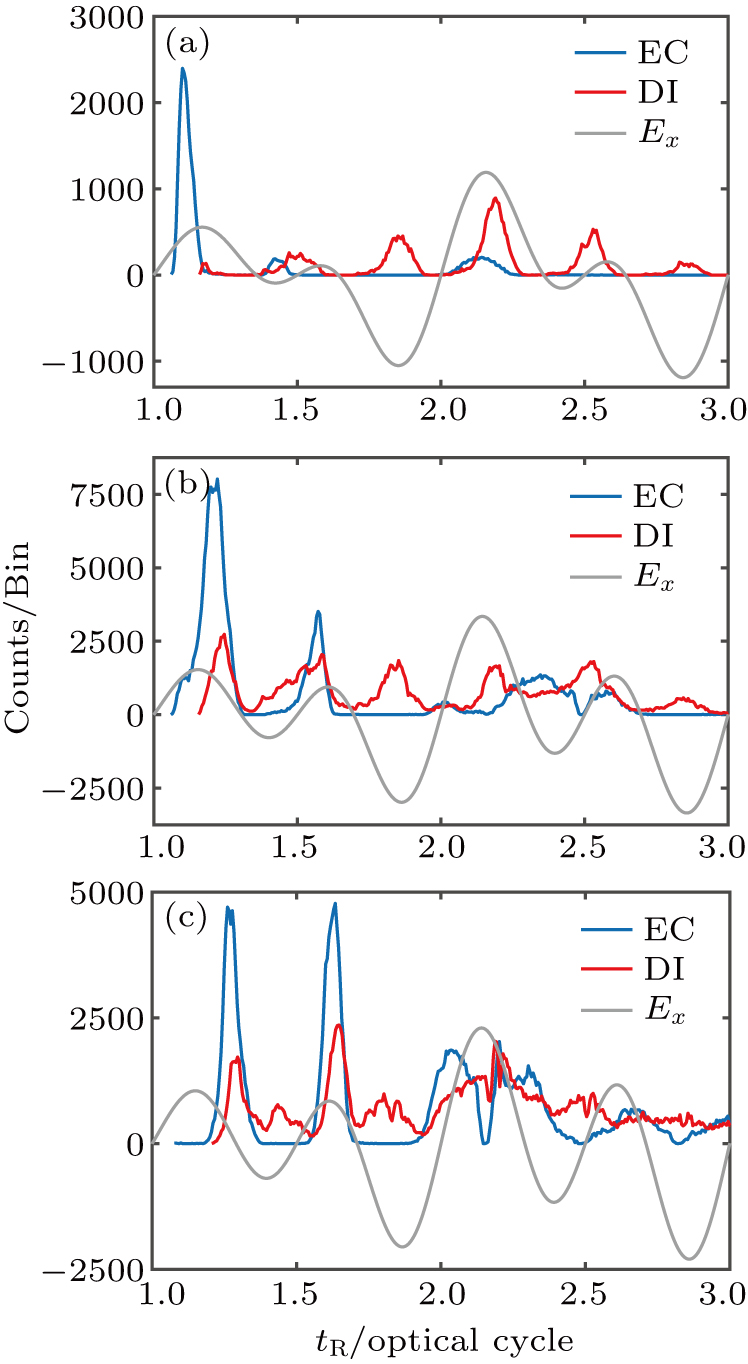† Corresponding author. E-mail:
Project supported by the National Natural Science Foundation of China (Grant Nos. 61475168, 11674231, and 61575124).
Electron collision as well as its controlling lies in the core of study on nonsequential double ionization (NSDI). A single collision occurred in a convergent time is important to disclose the essential features of the electron correlation. However, it is difficult to form such a collision. By using counterrotating circular two-color (CRTC) laser fields, we show that a single electron collision can be achieved in a convergent time and a net electron correlation is set up within the sub-femtosecond time scale in the NSDI process of Ar atoms. The proposed method is also valid for other atoms, provided that one chooses the frequency and intensity of the CRTC field according to a scaling law.
Controlling microscopic electron process lies in the core of study on intense light interacting with various matters.[1] When atoms or molecules are irradiated by intense laser fields, bound electrons can be ionized. The freed electron may turn back to its parent core when the electric field of the laser light reverses, which triggers many subsequent processes, such as rescattering process[2] and harmonic generation,[3–5] etc. The rescattered electron interferes with the directly ionized electron, changing the photoelectron angular distributions (PADs)[6] and causing the spider-lag structure in the PADs.[7] When the freed electron recombines with its parent core, high order harmonics are emitted in the attosecond time scale, which is an important source of attosecond pulse. Controlling the interference structure in the PADs and generating the attosecond pulses by modulating the driving laser fields were widely studied in the past decades.[8,9]
Non-sequential double ionization (NSDI) is also an important phenomenon frequently studied in the laser–atom interaction.[10–12] According to a three-step scenario,[13] the NSDI phenomenon denotes a process in which the returned electron collides with the parent nucleus. The impact increases the ionization rate of the second electron, and sets up an electron correlation. The electron collision and the electron correlation in the NSDI process were frequently studied.[10,14,15]
The electron correlation is established when the freed electron goes back to the vicinity of the parent core.[12,16–18] In a linearly polarized laser field, the freed electron encounters the nucleus twice in one optical cycle. Therefore, in a long laser pulse, the electron collision may occur in different moments. Consequently, the electron correlation is averaged among these multiple collisions and the essential features of a single collision are lost.[14] To disclose the losing features of the electron correlation, it is necessary to limit the electron collision occurring only once and at a time interval as short as possible. To this end, one may choose ultrashort laser pulses, but has to suffer the extremely low NSDI rate. Another choice is to increase the peak intensity, but the ionization will occur in the leading edge of the laser pulse. Thus one has to use the deliberately modulated laser pulses.[15] How to get single electron collision in a laser pulse is still an open problem.
Recently, the NSDI in counterrotating circular two-color (CRTC) fields have aroused much attention.[19–23] Both experimental and theoretical studies have shown that the CRTC fields can significantly improve the NSDI rate.[24] Meanwhile, the CRTC fields provide more parameters that can be used to control the electron collision. Chaloupka et al. have shown that the electron collision is finished within 0.2 optical cycle after the first electron is ionized.[20] This suggests the ionized electron travelling a very short trajectory before colliding with the parent core. This paves a way to control the electron collision by using the CRTC field. However, the laser conditions used to get the single collision in Ref. [20] are only suitable for He target, so more general conditions suitable for other targets still need to be explored.
In this paper, we study the NSDI of Ar atoms in the CRTC laser field and we focus on how to control the electron collision by choosing the proper laser fields. In order to obtain a single electron collision, we use a scaling technique to determine the driving laser field parameters. We will show that the electron collision process varies with frequency, peak intensity, and field ratio of the CRTC field, and can be limited to a sub-femtosecond time scale by properly choosing these parameters. The optimal conditions to control the electron collision are also discussed.
The method used here is based on the numerical integration of the time-dependent Newtonian equation, which is very effective in dealing with the NSDI phenomena.[25–27] Details of the method are presented in Ref. [28]. In brief, the motion of two electrons is governed by the canonical equation as





The energy of two electrons in the CRTC field varies with time. When the energy of an electron becomes positive, the electron is treated as being ionized, and the moment is regarded as the time of ionization. A double ionization (DI) event is counted if both electrons are ionized at the end of the laser pulse, and the moment of the second ionization is denoted as the time of DI. The time of electron collision is counted as the moment when the two electrons reach their shortest distance after first ionization. The back-trajectory technique[25,27] is used to seek for these moments.
The Ar atoms are frequently used target in the NSDI study, we mainly study the NSDI process of the Ar atoms. In the CRTC driving fields, the electron collision generally occurs in multiple time intervals,[22] so it is still not easy to get a single electron collision. Recently, using the CRTC field, Chaloupka et al. found that the electron collision in the NSDI of He target can be finished within 0.2T after the first electron is ionized.[20] This suggests the electron collision can be accurately controlled by using the CRTC fields. For the convenience of comparison and for a deep insight to the electronic dynamics, we first study the electron collision in the He atoms and then focus on the NSDI process of Ar atoms.
Figure
Next we study the NSDI of Ar atoms in the CRTC field of 800-nm wavelength but of lower intensity. Figures
To get a further insight into the electronic dynamics in the CRTC field, in Fig.
From the above discussion we see two points of NSDI process in the CRTC fields. One is that for the same field ratio, the tR–t1 curves keep similar features and the electron collision occurs shortly after the first ionization, which implies that the first ionized electron travels a very short trajectory in the CRTC field. The other is that the moment of electron collision may be quite different, although the time difference tR–t1 is quite small. This suggests that the tR curve discloses more details of the electron dynamics in the CRTC field. In the following, we mainly study the variation of tR curve with the laser fields.
In addition to the laser fields, the binding energy of the targets also affects the electronic dynamics. Under similar laser conditions, the electron collision occurred in the He target may differ greatly from that happens in the Ar target. In order to obtain the field parameters which are suitable to control the electron collision in other atoms, we use the scaling technique.
The scaling law for photoionization in intense laser fields was firstly proposed by Guo et al.[29] and was extended to the NSDI process recently.[30,31] The scaling law shows that electronic dynamics for atoms driven by a laser light of the frequency ω and intensity I is the same for another kind of atoms driven by a laser light of frequency kω and intensity k3ω, where k is the scaling parameter and equals the ratio of the second ionization potentials of two atoms. The electron correlation in different targets can be equivalent if one chooses the laser field according to the scaling law[32] and the conditions to observe the knee structure in rare atoms was found.[33] This suggests a way to get equivalent electron collision process in the target other than He atoms provided that he chooses the driving field according to the scaling law.
According to the scaling law, we choose ω = 0.028 a.u. (1575 nm) fields to drive the Ar target, which equals 0.508 times to that drives the He target. In Fig.
In the CRTC field, the field ratio of two colors, say ε in Eq. (
The pulse duration is an important factor affecting the double ionization process, especially when the laser intensity is not so high that the RESI process dominates the NSDI process. However, as the laser intensity is so high that a single collision is achieved, the double ionization occurs mainly in the leading edge of the pulse, and thus further increasing the pulse duration will not lead more double ionization greatly and our conclusion holds for laser pulses longer than five-cycle duration.
The ω–3ω CRTC field is another frequently used field in the study of NSDI. Compared with the ω–2ω CRTC field, where the combined electric field forms a clover-leaf structure, the electric field of the ω–3ω CRTC field exhibits a four-leaf pattern. This suggests the electric field in the ω–3ω CRTC field varies more quickly and the electron collision is expected to be finished in less time than that in the ω–2ω CRTC field. For this purpose, we study the electron collision in the ω–3ω CRTC fields, and some EC and DI curves are shown in Fig.
 | Fig. 4. Variation of EC and DI counts with time in ω–3ω CRTC fields. Other conditions are the same as those in Fig. |
In brief, we have shown that the electron collision can be achieved within 0.2T in the ω–2ω CRTC field, provided that the combined laser intensity is higher than 0.9 × 1015 W/cm2 and the field ratio is about 1.0±0.2. Further study discloses that when the laser intensity is in a range of 0.9 × 1015 W/cm2 to 1.7 × 1015 W/cm2, the EC curve shows a single peak. For the ω–3ω CRTC field, the collision time can be further limited within 0.1T, when the laser intensity is in a range of 1.3 × 1015 W/cm2 to 1.5 × 1015 W/cm2. For one optical period is about 5.3 femtosecond, our finding suggests that the electron collision can be finished within sub-femtosecond time scale.
Momentum distribution (MD) is frequently studied in NSDI. It provides an important assist to disclose the electron collision features. A question is what will it be when a single electron collision occurs in such short time scale? To answer this question, we study the MDs of electron pairs released via the RII process. It has shown that the final momentum of the ejected electron includes the initial momentum shortly after collision and the drift momentum that equals the vector potential of the laser field at the moment that it was born. For the RII electrons, two electrons can be treated as being ionized at the same time, so the drift momenta are the same. Therefore, the MD of the RII electrons encodes the momentum distribution at the moment of the electron collision.
Figure
Figure
The electron collision in the NSDI process of atoms can be controlled by properly choosing intensity and frequency of the CRTC driving fields. For the Ar atoms driven by the CRTC field with a fundamental wavelength of 1575 nm, the electron collision can occur only once within sub-femtosecond time scale. When the Ar atoms are driven by ω–2ω CRTC fields, the electron collision can occur within 0.2T. The optimal laser intensity is among the range of 0.9 × 1015 W/cm2 to 1.7 × 1015 W/cm2. When the Ar atoms are driven by ω–3ω CRTC fields, the electron collision can be limited within 0.1T. The optimal laser intensity is 1.3∼1.5 × 1015 W/cm2. The optimal field ratio of the two colors is about 1.0. When the single electron collision occurs, the MD of the recoil ion in the RII process exhibits a single maximum, and a net electron correlation is set up. The proposed method is also valid for other atoms, provided that one chooses the frequency and intensity of the CRTC field according to a scaling law.
| [1] | |
| [2] | |
| [3] | |
| [4] | |
| [5] | |
| [6] | |
| [7] | |
| [8] | |
| [9] | |
| [10] | |
| [11] | |
| [12] | |
| [13] | |
| [14] | |
| [15] | |
| [16] | |
| [17] | |
| [18] | |
| [19] | |
| [20] | |
| [21] | |
| [22] | |
| [23] | |
| [24] | |
| [25] | |
| [26] | |
| [27] | |
| [28] | |
| [29] | |
| [30] | |
| [31] | |
| [32] | |
| [33] | |
| [34] |






